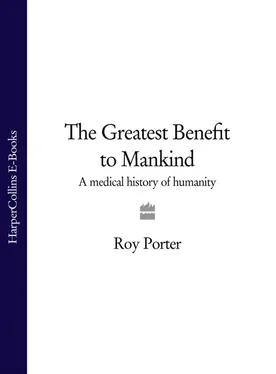It began with headache, rash and high fever, swelling and darkening of the face; next came delirium and the stupor giving the disease its name – typhos is Greek for ‘smoke’. Inflammation led to gangrene that rotted fingers and toes, causing a hideous stench. Spain lost 3,000 soldiers in the siege but six times as many to typhus.
Having smuggled itself into Spain, typhus filtered into France and beyond. In 1528, with the Valois (French) and Habsburg (Spanish) dynasties vying for European mastery, it struck the French army encircling Naples; half the 28,000 troops died within a month, and the siege collapsed. As a result, Emperor Charles V of Spain was left master of Italy, controlling Pope Clement VII – with important implications for Henry VIII’s marital troubles and the Reformation in England.
With the Holy Roman Empire fighting the Turks in the Balkans, typhus gained a second bridgehead into Europe. In 1542, the disease killed 30,000 Christian soldiers on the eastern front; four years later, it struck the Ottomans, terminating their siege of Belgrade; while by 1566 the Emperor Maximilian II had so many typhus victims that he was driven to an armistice. His disbanded troops relayed the disease back to western Europe, and so to the New World, where it joined measles and smallpox in ravaging Mexico and Peru. Typhus subsequently smote Europe during the Thirty Years War (1618–48), and remained widespread, devastating armies as ‘camp fever’, dogging beggars (road fever), depleting jails (jail fever) and ships (ship fever).
It was typhus which joined General Winter to turn Napoleon’s Russian invasion into a rout. The French crossed into Russia in June 1812. Sickness set in after the fall of Smolensk. Napoleon reached Moscow in September to find the city abandoned. During the next five weeks, the grande armée suffered a major typhus epidemic. By the time Moscow was evacuated, tens of thousands had fallen sick, and those unfit to travel were abandoned. Thirty thousand cases were left to die in Vilna alone, and only a trickle finally reached Warsaw. Of the 600,000 men in Napoleon’s army, few returned, and typhus was a major reason.
Smallpox, plague and typhus indicate, how war and conquest paved the way for the progress of pathogens. A later addition, at least as far as the West was concerned, was cholera, the most spectacular ‘new’ disease of the nineteenth century.
COLONIZATION AND INDUSTRIALIZATION
Together with civilization and commerce, colonization has contributed to the dissemination of infections. The Spanish conquest of America has already been mentioned; the nineteenth-century scramble for Africa also caused massive disturbance of indigenous populations and environmental disruption, unleashing terrible epidemics of sleeping sickness and other maladies. Europeans exported tuberculosis to the ‘Dark Continent’, especially once native labourers were jammed into mining compounds and the slums of Johannesburg. In the gold, diamond and copper producing regions of Africa, the operations of mining companies like De Beers and Union Minière de Haute Katanga brought family disruption and prostitution. Capitalism worsened the incidence of infectious and deficiency diseases for those induced or forced to abandon tribal ways and traditional economies – something which medical missionaries were pointing out from early in the twentieth century.
While in the period after Columbus’s voyage, advances in agriculture, plant-breeding and crop exchange between the New and Old Worlds in some ways improved food supply, for those newly dependent upon a single staple crop the consequence could be one of the classic deficiency diseases: scurvy, beriberi or kwashiorkor (from a Ghanaian word meaning a disease suffered by a child displaced from the breast). Those heavily reliant on maize in Mesoamerica and later, after it was brought back by the conquistadores, in the Mediterranean, frequently fell victim to pellagra, caused by niacin deficiency and characterized by diarrhoea, dermatitis, dementia and death. Another product of vitamin B 1(thiamine) deficiency is beriberi, associated with Asian rice cultures.
The Third World, however, has had no monopoly on dearth and deficiency diseases. The subjugation of Ireland by the English, complete around 1700, left an impoverished native peasantry ‘living in Filth and Nastiness upon Butter-milk and Potatoes, without a Shoe or stocking to their Feet’, as Jonathan Swift observed. Peasants survived through cultivating the potato, a New World import and another instance of how the Old World banked upon gains from the New. A wonderful source of nutrition, rich in vitamins B 1B 2and C as well as a host of essential minerals, potatoes kept the poor alive and well-nourished, but when in 1727 the oat crop failed, the poor ate their winter potatoes early and then starved. The subsequent famine led Swift to make his ironic ‘modest proposal’ as to how to handle the island’s surplus population better in future:
a young healthy Child, well nursed is, at a Year old, a most delicious, nourishing and wholesome Food; whether Stewed, Roasted, Baked, or Boiled; and, I make no doubt, that it will equally serve in a Fricassee, or Ragout … I grant this Food will be somewhat dear, and therefore very proper for Landlords.
With Ireland’s population zooming, disaster was always a risk. From a base of two million potato-eating peasants in 1700, the nation multiplied to five million by 1800 and to close on nine million by 1845. The potato island had become one of the world’s most densely populated places. When the oat and potato crops failed, starving peasants became prey to various disorders, notably typhus, predictably called ‘Irish fever’ by the landlords. During the Great Famine of 1845–7, typhus worked its way through the island; scurvy and dysentery also returned. Starving children aged so that they looked like old men. Around a million people may have died in the famine and in the next decades millions more emigrated. Only a small percentage of deaths were due directly to starvation; the overwhelming majority occurred from hunger-related disease: typhus, relapsing fevers and dysentery.
The staple crops introduced by peasant agriculture and commercial farming thus proved mixed blessings, enabling larger numbers to survive but often with their immunological stamina compromised. There may have been a similar trade-off respecting the impact of the industrial Revolution, first in Europe, then globally. While facilitating population growth and greater (if unequally distributed) prosperity, industrialization spread insanitary living conditions, workplace illnesses and ‘new diseases’ like rickets. And even prosperity has had its price, as Cheyne suggested. Cancer, obesity, gallstones, coronary heart disease, hypertension, diabetes, emphysema, Alzheimer’s disease and many other chronic and degenerative conditions have grown rapidly among today’s wealthy nations. More are of course now living long enough to develop these conditions, but new lifestyles also play their part, with cigarettes, alcohol, fatty diets and narcotics, those hallmarks of life in the West, taking their toll. Up to one third of all premature deaths in the West are said to be tobacco-related; in this, as in so many other matters, parts of the Third World are catching up fast.
And all the time ‘new’ diseases still make their appearance, either as evolutionary mutations or as ‘old’ diseases flushed out of their local environments (their very own Pandora’s box) and loosed upon the wider world as a result of environmental disturbance and economic change. The spread of AIDS, Ebola, Lassa and Marburg fevers may all be the result of the impact of the West on the ‘developing’ world – legacies of colonialism.
Читать дальше












